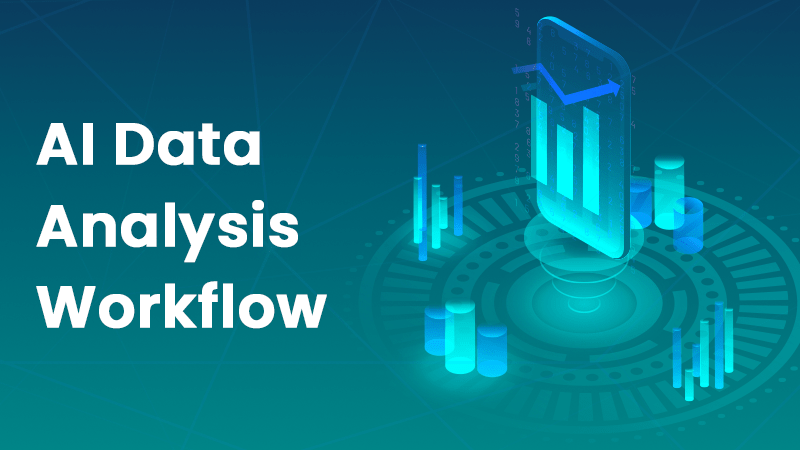
The AI Data Analysis Workflow
AI Data Analysis is a topic that has been discussed frequently at Qmantic. It is because it is an important part of the success strategy for companies to super-boost themselves. It refers to the art of using AI Technology to analyze data in its raw form and come up with a structured representation of it which adds to further insights and helps in decision making.
The workflow refers to the process. From the start of choosing and integrating data to the final visualized results, workflow refers to how a platform like Qmantic works and delivers results. In this article, certain important tips will be discussed that will make this process more productive and feasible.
Table of contents
The Importance and Challenges
It is important to heed the tips mentioned in the article because not only do they help to maneuver around the challenges, but they also introduce benefits. These benefits are important because they help in optimizing the process which as a result is important for the workflow.
- Efficiency,
- Accuracy,
- Economy,
- Scalability,
- Collaboration.
These benefits may sound nice and simple but they help around NOT having certain problems. There are, after all, certain challenges to the process of Data Analysis.
- Consistency: The first problem that any data set may suffer from is the quality. Data heavily depends on the nature and quality of information it has been trained upon. With inconsistencies and missing values that might have been overlooked by not checking them properly, ‘noise’ produced within the data heavily affects the outcome of the result.
- Preprocessing: There should be a noted balance between feature richness and computational efficiency. All these points should be checked beforehand.
- Algorithms: Often the Data at hand is not fully compatible with the AI algorithm that is used. It should be important to optimize hyperparameters and choose an appropriate AI to build a model. Sufficient research should be done.
- Resources: Everyone would want to process the data at hand in the best possible manner. It should be vital to pre-confirm the abilities of the resources at hand. AI data analysis requires significant computational resources. Certain organizations may find themselves lacking in this department. This is why providers like Qmantic cover for them and provide top-notch services.
- Integrations: One should also note that the data volumes that continue to grow are scalable, explainable, and integratable. Integrating AI models and workflows into existing systems and processes can be complex, which is why, security measures should be taken beforehand and should be done with careful planning.
That being said and done, let us now move forward to the actual tips on how to optimize your workflow.
Tip #1: Understanding the Data Requirements
Data is the fuel that powers AI models. This is why it is important to gauge the data volume before the start of the process. It should be sufficient, relevant, and on par with the computational power at hand. Similarly, it is also important to note that the data should not be corrupt or inconsistent. It should also be diverse, and cover every possible angle because AI models tend to perform better when trained on diverse and representative datasets.
Data should be proceeded for analysis only after it is confirmed that it is compatible. That is, it is labeled according to the AI model. Security should also be a checking point. Measures should be taken to protect sensitive information if it is part of the data set. Lastly, AI and data are both aspects that grow over the usage of time. It is important to maintain a clear record of data versions and provenance. This ensures reproducibility, auditability, and enables traceability of model performance and decisions.
Tip#2: Preparing and Cleaning of Data
While it might be synonymous with the first tip to an extent, it was necessary to mention it separately as well because of its importance. Cleaning of data refers to the process of removing errors and fixing inconsistencies before integrating the data with an AI model. This ensures a clean analysis giving more tailored and productive results.
After having dealt with anomalies, one should ensure that the data does not have spiking extreme values and that the features are similar to each other on a scale. Many AI algorithms are sensitive to the scale and distribution of input features, after all. Normalization and scaling techniques, such as min-max scaling, z-score normalization, or log transformation, can help ensure that features are on a similar scale, improving model convergence and performance.
Lastly, the process should be automated to save time and energy and remove human error. Qmantic offers a professional automated cleaning service, that cleans your data automatically before use, saving you the hassle of going through an additional step and trouble.
Tip#3: Choosing the Right AI Algorithm
There are hundreds, if not thousands, of AI algorithm techniques that are available. It is important to choose the right one that fits you instead of simply joining a bandwagon of popularity. This is the most crucial step in the process. To ensure that, it is a key factor to make note of the problem type. That is, classification, regression, clustering, or anomaly detection. Each algorithm is designed to give you a different result, which is why it is crucial to first know what you want and then act accordingly. In addition, it should also be decided at this stage whether to use models like decision tree or linear models etc. This should be done in accordance with what is required as the end result.
Next, be vary of the data size. The dimensionality, distribution, and potential noise or outliers, play a significant role in algorithm selection. Some algorithms are better suited for handling large datasets, while others may be more robust to noise or outliers. Other than the size, companies should be vary of their resources and limitations to computational architecture. Their actions should be on par with what’s available.
Another interesting point to note is that certain models are more adept at providing metrics such as accuracy or precision while others may be better at recall or prediction. Once again, it is vital to know what you are gunning for. In some cases, combining multiple algorithms through ensemble methods, such as bagging, boosting, or stacking, can yield superior performance compared to individual algorithms. Considering ensemble techniques can be a powerful strategy for optimizing AI data analysis workflows.
Tip#4: Optimizing for Better Performance
Optimizing the AI data algorithm also helps in optimizing the entire workflow. As mentioned in tip#3, choosing an AI algorithm that suits your data is the most important part of the process. Once that has been chosen, optimizing the said algorithm affects a great deal in the overall process and workflow. By optimizing, we refer to fine-tuning the AI data algorithm in a way that it complements the data at hand. Using techniques like ‘Grid Search’, ‘Random Search’, ‘Bayesian optimization’, and others can help regulate the architecture and is referred to as Hyperparameter tuning. This is vital to control the model’s behavior and tune it to one’s needs.
Other techniques like L1 (Lasso) or L2 (Ridge) regularization, dropout, early stopping, knowledge distillation, pruning, and compression help with dealing simpler and more complex data respectively. Ti allows for robust measures and helps in reducing the model’s size. In some cases, using pre-trained models can also prove effective instead of having to go about compressing it to match the computational needs at hand. An effective strategy to use larger models is to have them distributed over a cloud-based infrastructure. This reduces training time and enables for a more efficient optimization.
Combining multiple models through ensembling techniques, such as bagging, boosting, or stacking, can also help overcome any particular weaknesses by relying on the strengths of other assimilated models. As AI models degrade over time due to their nature, optimization and upgradation is mandatory and required. Which is why interpretability and explainability becomes crucial. For this, techniques like SHAP (SHapley Additive exPlanations), LIME (Local Interpretable Model-agnostic Explanations), or attention mechanisms can provide insights into model behavior and decision-making processes, which in turn helps in efficient regulation and management of the model.
Tip#5: Automating the Process of Analysis
The use of AI in technology was done so with the mission of having most processes be automated. That was the fundamental vision behind it. Automation helps you save time, energy, and skill. Which is why, the last tip mentioned in this article is about automating the process to optimize the workflow and process of data analysis. This is done by utilizing AI tools and services. An example of the said would be Qmantic itself. It helps give you a structured approach to managing the entire workflow.
Explaining the process of automating in detail would be repeating most of the points already mentioned above. After all, automation refers to the use of AI and the mentioned points were all about how to use the said AI in an efficient manner. While services other than Qmantic also offer AI data analysis, one should make a full study on what models are used and how it makes them efficient for data analysis. Qmantic implements CI/CD practices to automate the build, testing, and deployment processes for AI models which ensures for a validated environment of the AI model being used, reducing the errors and facilitating rapid iteration. Qmantic also streamlines the ingestion, procession, and preparation of data by building automated pipelines. This helps in the cleaning, transformation, and extraction of data. In addition, monitoring setups are put in place to keep check on the data and its validity. In short, it helps keep a check on when the data needs to be updated and regulates the process.
To better capitalize on the automation practices, it is advised for the users and companies to generate comprehensive documentation and reports. This helps in the longer run of the picture. It helps in better understanding the needs of the data and process at hand and helps boost various performance metrics. Lastly, services like Qmantic that provide cloud-based management should be preferred for their cost-effective automation and on-demand access to resources used in the process of the said analysis.
Qmantic’s Conclusion
In this article, we discussed in detail about the process of data analysis and tips that may help in the said process. We also mentioned Qmantic’s role in the delivery of all the aforementioned services, skills, and resources. After all is said and done, automation and optimizing your workflow reduces the risk of human errors, facilitates collaboration, and enables faster iteration and deployment cycles, ultimately leading to more accurate and timely insights. At Qmantic, we specialize in providing tailored solutions to help you implement best practices, and achieve optimal performance and efficiency in your AI workflows. Join us today and welcome yourself to a whole new optimized future of AI Data Analysis.





